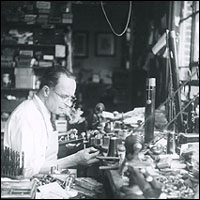Hans Moennig (1903–1988), a woodwind artist-technician in Philadelphia, worked hand-in-hand with Tabuteau in keeping his Lorée oboes in excellent playing condition. Tabuteau often frequented Moennig’s 2nd floor shop at 15 South 21st Street in Philadelphia. As an extreme example of Tabuteau’s light touch on the oboe keys, Donald Hefner reports the following in his dissertation The Tradition of the Paris Conservatoire School of Oboe Playing with Special Attention to the Influence of Marcel Tabuteau as related to him by Moennig:
In 1926 Moennig had just opened his shop in Philadelphia with the encouragement of his uncle, Walter Guetter (then Principal Bassoonist of the Philadelphia Orchestra). Word soon spread that there was a skillful young technician in the city, and so it was not long until his shop was visited by the great Tabuteau, who entrusted him with the adjustment of his oboe, claiming that there was leakage in the note ‘g.’ With scrupulous care (which characterized his work throughout his life) he replaced that pad and saw to it that the instrument was completely airtight.
A day later, Tabuteau was back, claiming that the note was still leaking. The work was done again, even more carefully.
When Tabuteau returned a third time, Moennig was beside himself. “Maestro, will you let me watch you play that note?” he asked him. When Tabuteau did so, Moennig said, “Maestro, you must touch the key with at least enough force so the pad will touch the rim of the hole.”
The following information as to whether Tabuteau used a bell reamer is made clear by the email below from John Symer, who is familiar with Hans Moennig’s shop and his interactions with Marcel Tabuteau.
The above photo was sent in by Brent Hages who bought the reamer from Fred Capps who bought it from Lou Rosenblatt. Brent was wondering whether it could have come from Moennig’s shop and used by Moennig to match Tabuteau’s favorite bell, or even used by Tabuteau himself, since the box it was kept in was labeled “Moennig – Tabuteau bell reamer.”
Here is John Symer’s reply:
That particular tool was made for Lou Rosenblatt, I don't know when, by Milt Ruttenberg. Milt was an amateur oboist, owned an authentic AL series Lorée oboe, among the very last of Lucien Lorée (before Lorée's untimely mishap with the gas supply in occupied Paris), and the father of Lou Rosenblatt pupil, oboist Louis Ruttenberg, formerly assoc principal oboe Houston Symphony, now a chef, I believe. Milt lived pretty close to where I now live, Cherry Hill, NJ, but owned a precision machining business in Philly, thus the reamer was easy for someone who made rocket parts for the DOD! Milt, in the 1990s, made a set of oboe reamers (lots of them!) for me, as a retirement project and for something to do when his wife got sick. He was a sweet person, and I learned some pretty cool machining tricks from him. I know that the particular reamer in your picture, because it has three or four flutes, is quite labor-intensive to use.
To my knowledge, Tabuteau didn't modify bells with a reamer, he used whatever reed knife he had in his hands! You see, the standard Lorée bell has a bore which, for 25mm or so mimics the flare of the oboe's bore, then commences its own more conical shape. So Tabuteau, later Moennig, would cut away some of the step between the more cylindrical and more conical flares of the bell bore. Moennig also had a setup on a lathe for the cutting, but still done more or less by hand. I've got his hand-carved templates and gauges FYI. It was the advent of the de Lancie model and de Lancie's French-made reamers for the bottom joint and bell (lately in possession of Weber, but not producing great results due I think to dullness issues or misuse) that must have prompted Lou Rosenblatt to want a reamer of his own.
By the way, the whole point of the bell reaming was to open up the feel of the low notes, with the side benefit of fixing the stability and pitch of the middle E, F# and G. Lorée's introduction of the AK bell in the 1980s, to me, pretty much eliminates the need for the reaming anymore!
Of course, everybody has opinions about all this stuff. I think I ought to devote a chapter to this whole topic in my book, whenever THAT gets going.....with the exception of Tabuteau himself, I knew all the main cast members!
More on Hans Moennig here.


